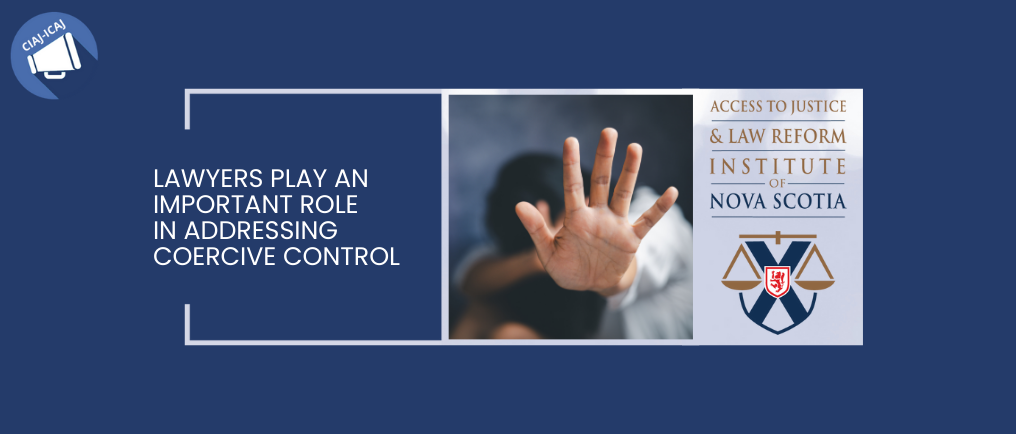Lawyers Play an Important Role in Addressing Coercive Control

In the last four months in Nova Scotia, 6 women have been killed in murders attributed to intimate partner violence (IPV). These tragic deaths all occurred since Nova Scotia’s official declaration that IPV is an epidemic.
IPV is a Canada-wide problem, with numerous inquiries, inquests and committees dedicated to understanding IPV-related homicides and what to do about this pervasive and insidious issue. Canada also now has a National Action Plan to End Gender-Based Violence with a stated goal to improve justice outcomes for those impacted by gender-based violence.
Here in Nova Scotia, we have also seen the release of one of Canada’s most comprehensive reviews on how the justice system and wider society can both address and prevent IPV in the Mass Casualty Commission’s Final Report: Turning the Tide Together. The Mass Casualty Commission (MCC) further drew attention to an especially dangerous and often misunderstood form of violence – coercive control.
Understanding and Identifying Coercive Control
Recent changes to Canadian law such as Keira’s Law, amendments to the Divorce Act and the potential criminalization of coercive control, all speak to the central role that the law and legal professionals have in identifying and responding to coercive control. Coercive control can be a difficult type of violence to understand, and legal academics, lawyers and courts alike are currently grappling with how to identify and respond to it, including the impact on a lawyer’s ethical duties.
In a roundtable discussion before the MCC, Dr. Lori Chambers of Lakehead University explained how coercive control can be rendered invisible because it may not be paired with what people see as more typical markers or signs of IPV. She explained to the Commission:
- … Coercive control is a pattern of behaviour that develops over time, which uses isolation, intimidation, and control to keep women from being free to make decisions for themselves, to keep them tethered to men who treat them with complete and utter disrespect. It does not have to include a lot of daily [physical] violence …
- Women are not necessarily being hit all the time … they don’t have blackened eyes and broken bones. They’re not showing up in the hospital, necessarily. What they experience instead is a kind of micro-regulation of absolutely everything they do all day long.
- … Their partners … start out with what appears to be loving concern and correction of their behaviours, which turns into a really totalitarian regime which feels like you are a victim of kidnapping or a prisoner of war.
In their submission to the House of Commons Standing Committee on Justice and Human Rights on the Study of Controlling or Coercive Conduct within Intimate Relationships, the Canadian Resource Centre for Victims of Crime provided five specific examples of coercive and controlling behaviours, paraphrased in part here:
- Being forced to cater to a partner’s every need: For example, one victim was made to towel their partner off after his showers and dressing him, frequently having to start over if he did not “like his outfit”.
- Financial abuse: For example, taking Child Benefit payments or money intended for the children, or forbidding a survivor from spending money on essentials. In cases of financial control, a partner can exercise a tremendously strong hold on victims via access to bank accounts (joint accounts, or knowledge of passwords), monitoring of spending, severely impairing a survivor’s credit score or making them take out high interest “pay day” loans.
- Undermining one’s autonomy and ability to make decisions for oneself: For example, being denied the right to work or constantly undermining efforts to obtain work.
- Stalking behavior during/after a relationship: For example, breaking into the home and making changes (such as rearranging furniture) to intimidate the survivor, sending threatening messages to or via the children, or showing up unannounced at workplaces, schools, homes or other locations to “check in”.
- Threats of violence and intimidation: For example, lunging at a survivor in a bid to physically them but never actually physically harming them.
In a recent article, Dr. Peter Jaffe and colleagues noted that patterns of coercive and controlling behaviours can be very case specific, and attention must be paid to intersectionality and identity to understand coercive control in each relationship. For example, threats to call child protection on a Black or Indigenous partner, threats to revoke a newcomer’s sponsorship, or threats to ‘‘out” a 2SLGBTQIA+ partner may contribute to a larger pattern of coercive and controlling behaviour.
Tactics of coercive control can also target a person’s mental health or substance use, for example, by undermining their ability to participate in treatment or asserting control over medication or substances.
Coercive Control and Family Law: Why Does it Matter?
While difficult, trying to understand coercive control is essential, as it is an extremely dangerous form of family violence that puts both survivors and children at risk. In evidence provided to the Standing Committee on Justice and Human Rights, Professor Jennifer Koshan shared that coercive control is a risk factor for femicide[1]. The Standing Committee further heard that coercive control is “one of the best indicators of lethality,” especially when a survivor is attempting to leave an abusive relationship. Dr. Chambers explained to the MCC why this is the case:
- In coercively controlling relationships, the most dangerous moment is when you attempt to leave, because it is about control; it’s not about violence. It’s about controlling you and keeping you. … If you’re refusing this paradigm, then you’re now at risk of being killed because this is the moment when you are threatening power and control of your coercive controller.
Parents who use coercive controlling violence are also more likely to continue to use violence post-separation, for example by directing violence toward their children, by controlling parenting arrangements (for example, withholding the children), or engaging in litigation abuse. In the case of Bell v. Reinhardt, 2021 ONSC 3352, the court cautioned to be wary of crafting parenting arrangements that may lead to further opportunities for violence.[2]
Clients may not always identify to a lawyer that they are in a coercive controlling relationship. In a brief for the MCC and a report for Justice Canada, Dr. Mary Aspinall and Dr. Carmen Gill noted that because abuse and control may be a gradual process, it can be difficult for survivors to recognize that they are experiencing abuse. Survivors may even blame themselves, and over time may be stripped of the confidence and agency needed to assert themselves and make decisions.
Lawyers working with clients who are considering leaving an abusive relationship therefore become a critical touchpoint to help support the safety of survivors and their children during this precarious period. A lawyer may be the first person a survivor turns to for help, making screening, identification and response to family violence a critical undertaking. In addition to making appropriate community referrals and flagging risks, lawyers can assist clients through safety planning and crafting safer parenting arrangements.
In our last blog post, we included resources on screening for domestic violence. Below, we list a number of resources produced by experts, family law scholars and practitioners that can help family law lawyers to learn more about coercive control, how to identify it and what to do about it.
RESOURCES
What is Coercive Control?
- What is Coercive Control? (Blog – Luke’s Place)
- HELP Toolkit: Identifying and Responding to Family Violence for Family Law Legal Advisers (See pages 48-49)
- Coercive Control as a Form of Family Violence (Fact Sheet – Dr. Jaffe et al.)
- How to Spot the Warning Signs of Coercive Control in a Relationship (Video – Globe and Mail)
- Coercive control can be a life or death issue in relationships. But few people even know how to recognize it (Article – Globe and Mail)
- Managing Domestic Violence: A Practical Handbook for Family Lawyers (Desmond Ellis)
- The Homicide Timeline: A model for understanding risk of homicide in coercive controlling relationships (Research Brief – Transition House Association of Nova Scotia)
- For a detailed exploration of coercive control, see the Expert Report prepared for the Mass Casualty Commission, “Understanding Violence in Relationships” (Drs. Gill & Aspinall)
The Impact of Coercive Control on Children and Parenting Arrangements
- Coercive Control and Family Law (Brief – Family Violence & Family Law)
- Enhancing Judicial Practice by Integrating Coercive Control (Webinar – Learning Network)
- Identifying Coercive Control in Canadian Family Law: A Required Analysis in Determining the Best Interests of the Child (Article – Lux & Gill)
- Keira’s Legacy of Hope: Judicial Training on Family Violence (Webinar – Learning Network)

